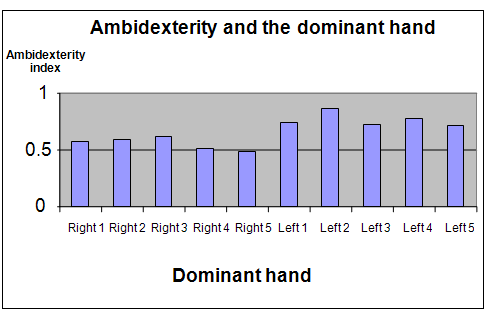| Complexity level: | 5 |
| Project cost ($): | 10 |
| Time required: | 1 hour to prepare, 1 hour for the science project experiment |
| Material availability: | Easily found |
| Safety concerns: | Basic safety requirements |
Hypothesis
There are more ambidextrous left-handers than right-handers.
Overview
Left Handedness and ambidexterity
Left handedness is a hereditary trait where a person prefers to perform normal chores using the left hand instead of the right hand. A left-handed person is normally not alone in a family. Normally a sibling, parent or cousin will also be left-handed. This means that the left-handed trait is hereditary. Less than 10% of the population is left handed.
It is believed by scientists that left-handed and right-handed persons use different sides of their brain to control their actions. The nerves that come originate from the brain will cross sides near the region of the neck. This means that a right is more inclined to use the left side of the brain and a left-handed person is more inclined to use the right side of the brain.
Ambidexterity is a rare condition where a person is able to perform a given task equally well by using both hands. Although very few people are actually born ambidextrous, it is a trait that can also be learned by practice. It is believed that most ambidextrous persons are left-handed because although they are naturally left-handed, schools or families discourage the use of the left hand and force them to learn to use the right hand.
Scientific Terms
Materials
The materials required for the science fair project experiment:
- 5 left-handed participants
- 5 right-handed participants
- 10 scissors
- 20 copies of paper with 5 objects drawn
- 10 bolts and nuts
- 1 stopwatch
Procedure
1. For this science fair project, the independent variable is the nature of the tasks given to the participants – cutting paper and fixing a nut to a bolt. The dependent variable is the time taken by the participants to complete the given tasks. The time taken is measured using a stopwatch. The constants (control variables) are the size of the objects to be cut, the thickness of the paper, the size of the nut and the bolt.
2. The 10 participants will be given two tasks to complete:
a. For the first task, they will be given a pair of scissors and a piece of paper with 5 objects drawn on it. They are required to cut out the objects using one hand. They are allowed to hold the paper with the other hand.
b. For the second task, they will be given 5 bolts and 5 nuts. Using only one hand, they must fix the nut on to the bolt. They are not allowed to use their other hand.
3. The 10 participants are first required to perform the task using their dominant hand. The dominant hand will be the right hand for a right hander and the left hand for a left hander. Both the tasks will be performed continuously and the total time taken is recorded in the table given below.
4. The participants will next be required to complete both tasks using their less-dominant hand. The time taken is recorded in the table given below.
5. Their level of ambidexterity is calculated using the formula below and recorded in the table. A figure close to 1 represents high ambidexterity and a figure close to 0 represents poor ambidexterity.
Ambidexterity level = (Time taken using less dominant hand)/ (Time taken using dominant hand)

Results
It was observed that the left-handed participants demonstrated a higher level of ambidexterity compared to the right-handers.
|
Testing ambidexterity |
Time for right hander to complete task (seconds) |
||||
|
Right 1 |
Right 2 |
Right 3 |
Right 4 |
Right 5 |
|
|
Dominant hand |
72 |
81 |
89 |
62 |
69 |
|
Less Dominant hand |
124 |
138 |
143 |
121 |
141 |
|
Ambidexterity |
0.58 |
0.59 |
0.62 |
0.51 |
0.49 |
|
Time for left hander to complete task (seconds) |
|||||
|
Left 1 |
Left 2 |
Left 3 |
Left 4 |
Left 5 |
|
|
Dominant hand |
69 |
78 |
59 |
81 |
78 |
|
Less Dominant hand |
93 |
91 |
81 |
105 |
110 |
|
Ambidexterity |
0.74 |
0.86 |
0.73 |
0.77 |
0.71 |
The chart below represents the results of our science project experiment.

Conclusion
The hypothesis There are more ambidextrous left-handers than right-handers, is proven to be true.
Ambidexterity gives a person an added advantage in sports, art, music and martial arts. It is a highly prized gift in sports like baseball and snooker. Most musical instruments are played using two hands. The great artist, Michelangelo was able to paint using both his hands.
Also consider
To improve the reliability and accuracy of our results, a larger sample of participants should be used.
This science fair project may be repeated, this time, to observe if the level of ambidexterity is affected by the age of a person.
Modify the science project experiment, using different tests to check ambidexterity - such as measuring the time taken to copy a 100 word essay using different hands.
References
Left handedness - http://en.wikipedia.org/wiki/Left-handedness
Why are some people left handed? - http://www.coolquiz.com/trivia/explain/docs/lefthand.asp
Ambidexterity - http://en.wikipedia.org/wiki/Ambidexterity

